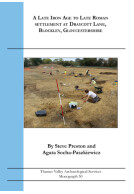Google Books previews are unavailable because you have chosen to turn off third party cookies for enhanced content. Visit our cookies page to review your cookie settings.
A Beaker Pit, an Iron Age and Late Roman Occupation at Laurels Road, Offenham, Worcestershire (Paperback)
Imprint: Thames Valley Archaeological Services
Series: TVAS Monograph Series
Pages: 71
ISBN: 9781911228707
Published: 28th February 2025
Script Academic & Professional
Series: TVAS Monograph Series
Pages: 71
ISBN: 9781911228707
Published: 28th February 2025
Script Academic & Professional
Usually available in 6-8 weeks.
You'll be £15.00 closer to your next £10.00 credit when you purchase A Beaker Pit, an Iron Age and Late Roman Occupation at Laurels Road, Offenham, Worcestershire. What's this?
+£4.99 UK Delivery or free UK delivery if order is over £40
(click here for international delivery rates)
Need a currency converter? Check XE.com for live rates
(click here for international delivery rates)
Need a currency converter? Check XE.com for live rates
Archaeological excavation of a 0.64ha area in advance of development of a larger field produced evidence of use of this landscape from the late Neolithic/early Bronze Age (Beaker period), middle to late Iron Age and middle to late Roman, besides later ridge and furrow. The Beaker period was represented only by a single pit containing the period’s distinctive pottery, with no evidence of the burial that often accompanies such deposits. A large C-shaped ditch can be dated to the Middle Iron Age, although it also received later pottery. It cut across a couple of field boundary ditches which also underlay a square enclosure surrounding a grave of Late Iron Age date. The burial, of a man aged in his 40s or older, had been placed beneath stone slabs but with no grave goods (except some probably incidental pottery sherds). A radiocarbon date places the burial (most probably) in the late 1st century BC or early 1st century AD. The main results of the excavation, however, date to the Roman period, from the middle of the 2nd century until the late 4th or even early 5th century. it had been anticipated that the site might contain a villa but no such structure was located, the features being mainly ditches, representing field boundaries or enclosures. Nonetheless some f the finds assemblages do suggest a relatively affluent site and it remains possible that there is a villa nearby, and the presence of a presumed corn-dryer tends to support this suggestion. A suggestion of continuity into the 5th century is difficult to substantiate on any grounds other than the stratigraphic depth of the ‘latest Roman’ period which has to accommodate at least three sub-phases involving fairly substantial changes in layout and seems difficult to reconcile with a shorter chronology entirely confined to the late 4th century. The latest feature, a very large ditch, puts the earlier field systems completely out of use.
Other titles in the series...
Other titles in Thames Valley Archaeological Services...











